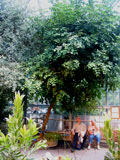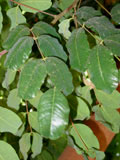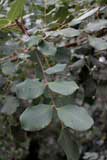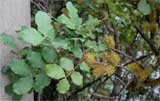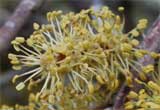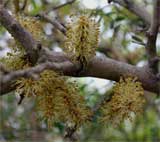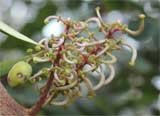|
|
||
This article was published in the "Hortuskrant" of September 2005 of the "Botanical Garden of Amsterdam"
by Fred Triep
|
On this webpage I give attention to the carob tree, in connexion with
the theme “Fruits and Seeds” of the Hortus Magazine. This tree makes
large pods of thirty to forty cm length. The carob tree (Ceratonia siliqua) is native to the eastern part of the Mediterranean, but was spread in historical times in the whole area. The tree was later brought to the New World, where it thrives in Mediterranean areas with hot, dry summers and cool winters (California, Australia). |
|
The
tree
The tree can become 7 till 10 meters high. He is slowly grown: the first
flowers appear only after 5 till 6 years. The pinnately compound leaves are
scattered along the stems. They are made up of six to ten small leaflets of two
and a half to six cm in length, each of which is oval in shape with a rounded
point.
Flowering
The flowers appear in small plumes from September and are arranged in a spiral to the flowering axis. In most plants the flowers are budding at the new plant parts, but in this tree they arise on the old bare wood, a phenomenon called cauliflory. The small flowers are inconspicuous and six to twenty-two mm long. Although this tree belongs to the family Fabaceae, the flower of the carob does not look like that of other members of this family. Plants of the Fabaceae have asymmetric flowers that consist of five petals. The two lower petals form the keel, which encloses the pistil and stamens. On either side of this are two petals, which are called the swords. The upward petal is called the flag. The flower as a whole resembles a butterfly. But in the carob tree the petals are absent. There are sepals, which are green to red.
Pollination and
fruiting
The trees have unisexual flowers (only male flowers or
only female flowers) or hermaphroditic flowers. The different sexes grow on
different trees. Insects (bees and flies) ensure the pollination, but
researchers have discovered that even the wind can do that. The pods and beans
of the carob tree are very nutritious. The name Johannisbroodboom in Dutch and
German comes from the tradition that John the Baptist would have eaten the pods.
The tree is also called carob tree, which derived via the Spanish (algaroba)
from the Arabic kharoub. The pods contain five to fifteen seeds. The ancient
Greeks discovered that the beans have often identical weight. Therefore, the
beans were used in the comparison of weights. Thus arose the name carat, a
weight that is roughly equivalent to 200
milligrams. Later this term was used in gold and gems.
Left: A carob tree in south
Spain with fruits (pods) Photo's : Fred Triep
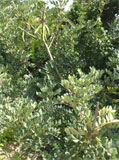
Click on the thumbnails
when you want to see the large pictures
Right: The fruits (pods) of a carob tree
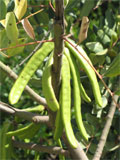
Use of the
pods
The pods are in Southern Europe often used as fodder. In
tough times, they were also eaten by people. The pods contain a lot of sugar and
eating it has a laxative effect. Often the pods are ground into a powder, which
is rich in fiber and sweet.
The beans themselves are rich in protein. They
are ground into flour, which can be baked. Also, this flour is used as a
substitute for chocolate, by mixing it with cold or hot milk.
In the food
industry carob flour is used as an emulsifier in various food products (ice
cream, sauces, salads, etc.). In Europe it is permitted as a food additive under
number E 410.
The carob trees tolerate only light frosts: up to four degrees. Therefore they occur in Spain and Portugal only along the coast. Nevertheless, Spain is the largest producer of the pods, but they are now also grown commercially in Australia.
Only recently (in 1980) there was described a second species from the genus Ceratonia, namely C. oreothauma. Of this species there are two subspecies, one from Oman and one from Somalia.
In the Botanical Garden of Amsterdam you can find the carob tree in the subtropical part of the “Drie- Klimaten Kas” (Three Climates Greenhouse), immediately to the right of the entrance. Under the tree is a bench, so you can look the tree comfortable
Literature
Oleg Polunin and Anthony
Huxley
Flowers of the
Chatto and Windus,
L. Battle and J. Tous
Promotions and use of underutilized and neglected crops,
17 Carob tree- Ceratonia siliqua
International Plant Genetic Resources Institute, 1997
http://www.ipgri.cgiar.com/publications/pdf/347.pdf
Stevens, P.F. (2001 onwards).
Angiosperm Phylogeny Website. Version 5, May 2004
http://www.mobot.org/MOBOT/research/APweb/
Neerlands tuin- Johannesbroodboom, Ceratonia,
http://www.neerlandstuin.nl/struiken/ceratonia.html
Cauliflory
http://waynesword.palomar.edu/plmay99.htm
This page is newly created on Monday 7 January 2013.
![]()
For additions or comments, please send me an email:
| Terug naar (return to): | Return to: |

